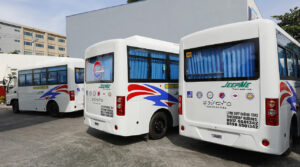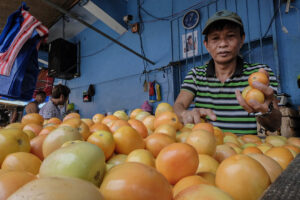By Justine Irish D. Tabile, Reporter
THE PHILIPPINES can establish a niche for itself in commercial electric vehicle (EV) manufacturing as its entry point into the global EV supply chain, by enlarging the existing base market created by public utility vehicle (PUV) modernization, regulators and industry officials said.
“We still have not missed the boat of EV manufacturing since we are already on the boat,” Board of Investments (BoI) Industry Development Services Executive Director Ma. Corazon H. Dichosa told BusinessWorld in an interview.
“Several electric PUV and three-wheeler assemblers are already here in the Philippines. There are companies assembling battery packs here, and our electronics manufacturing services companies are already supplying relevant electronics components for EVs,” she said.
She added that PUV modernization could serve as a jumping-off point for electric PUV (ePUV) assemblers.
“The production of electric commercial vehicles and ePUVs could pose a significant opportunity for our niche EV market considering the capabilities of our auto parts makers and our need to modernize and electrify our public transport system,” Ms. Dichosa said.
In a separate interview, Electric Vehicle Association of the Philippines (EVAP) Chairman Emeritus Ferdinand I. Raquelsantos told BusinessWorld that the Philippines is still in the EV game.
“Although we have been overtaken by others, I still believe if we can develop local production of commercial vehicles, not only can we supply the Philippine market but also export because nobody is making commercial vehicles in ASEAN,” he said, noting that China is the other current maker of commercial EVs.
“Everybody is focused on passenger cars, so we should focus on something that they are not in, such as Asian utility vehicles, whose chassis is (applicable to) delivery vans,” he added.
He said that the Philippines could continue investing in commercial vehicles as they can be used for public transport and be exported to serve logistics customers like delivery services, among others.
“Unfortunately, we still don’t see any original equipment manufacturers (OEMs) interested in locating in the Philippines for completely knocked down (CKD) assembly. In Thailand, by the end of this year, there will be 11 brands doing CKD assembly of EVs,” he said.
He said that among those that went to Thailand is China’s BYD, which the Philippines had been seeking to attract.
“For the last 2-3 years, the market has been favoring BYD. BYD is number one in EV sales worldwide when it comes to passenger cars, and it decided to go to Thailand. It was the first one, actually, to assemble CKDs in Thailand,” he said.
“Although our focus is actually on PUVs, we’re still working in that direction. Because of course, it would be nice if there would be a different brand principal that would do CKD assembly in the Philippines,” he added.
ADOPTIONAccording to Ms. Halili-Dichosa, EV adoption in the Philippines is expected to hit 5% by the end of the year, based on the projections of the Accelerating the Adoption and Scale-up of Electric Mobility for Low-Carbon City Development in the Philippines project.
“New EV sales in the Philippines totaled 11,584 units in 2023 and 10,001 units in the first half of 2024,” she said.
“This constitutes around 3% adoption vis-à-vis total vehicle sales in 2023 and 4.4% for the first half of 2024. It is expected that the adoption rate will increase to 5% by the end of the year,” she added.
She said adoption is increasing due to the influx of new vehicle releases and the closing of the price gap between EVs and internal combustion engine (ICE) vehicles.
“Currently, EVs are 20-40% more expensive on average compared to their ICE counterpart,” she added.
Asked what level of adoption would constitute critical mass for more assemblers to enter the market, she said that would depend on current and forecasted demand and on the development of the industry’s value chain.
“We currently have several EV manufacturers in the country, particularly focusing on ePUVs and electric tricycles. Based on consultations with various assemblers, a ballpark demand of around 1,000-2,000 units per year would be a viable business case for them,” she added.
In terms of local content, she said the Philippines can manufacture body shells, large plastic parts, chassis, wheels and tires, and vehicle electronics.
For EVs, she said the Philippines has the capacity to produce battery packs at St Baker Gigafactory and Greener Solar Power & Electric Motor, Inc. and EV charging stations through BTC Power.
“But we still need to pursue expanding this existing supply chain to enhance competitiveness in local manufacturing and assembly,” she said.
“Based on estimates, our auto parts industry can supply local content of between 20% and 60-70%, considering the potential value added from using locally assembled battery packs,” she added.
EVs are estimated to account for 2-3% of all vehicles registered with the Land Transportation Office in 2023, EVAP President Edmund A. Araga said.
“It is still far from (the adoption of) ICE vehicles, as not all Filipinos will switch immediately to EVs because they do not understand the full benefits of using EVs due to cost and charging infrastructure concerns,” Mr. Araga told BusinessWorld via Viber.
According to the Department of Energy (DoE), the Philippines had 833 EV charging points as of the end of November.
“This consists of 329 alternating current charging stations, 41 direct current charging stations, and 463 battery swapping stations,” according to Patrick T. Aquino, director at DoE’s Energy Utilization Management Bureau.
Mr. Raquelsantos said that one of the factors that makes other countries attractive for EV assembly investment is the clustering of parts makers.
“Obviously, in Thailand, they have a lot more local parts makers, so their supply chain is much better, much more complete. And because they have volume, the price of the parts is cheaper,” he said.
“Even CKD assembly is about P100,000 cheaper to produce in Thailand than in the Philippines. So those are the things that explain why foreign investors go to Thailand,” he added.
POLICYAsked why he thinks such investments have been going to countries like Thailand, Mr. Raquelsantos said it is mainly due to better incentives and benefits.
“Here in the Philippines, a foreign company who will export or whatever has to lease property. In Thailand, it’s free. So right away, if you’re an investor, your cost goes down because the rent is free,” he said.
“And of course, in terms of bureaucracy in getting local permits and government permits, it’s much harder here than in other countries,” he added.
He said that although the Corporate Recovery and Tax Incentives for Enterprises to Maximize Opportunities for Reinvigorating the Economy (CREATE MORE) Act is set to improve incentives enjoyed by registered business enterprises, it will not be enough compared to Thai offerings.
Representative Rufus B. Rodriguez has said that “CREATE MORE is a ‘one size fits all’ measure that may not address the concerns of the automotive industry.
He noted that the government should pass a bill that expands incentives on offer under the Comprehensive Automotive Resurgence Strategy (CARS) program to other manufacturers.
A bill aimed at increasing the incentives given to car manufacturers has been with the House Committee on Trade and Industry since September 2022.
Mr. Araga noted the incentive packages already available under the Electric Vehicle Industry Development Act and Comprehensive Roadmap for the EV Industry.
“But we are still hoping for some amendments in terms of zero tariffs under Executive Order (EO) 62,” he added.
On June 20, President Ferdinand R. Marcos, Jr. signed EO 62, which modified the nomenclature and rates of import duty on various products.
The EO covered the expansion of the reduced Most Favored Nation tariff rates of the products covered under EO 12 to other battery EVs, hybrid EVs (HEVs), plug-in hybrid EVs (PHEVs), and certain parts and components.
Aside from the 34 lines of EVs covered by EO 12, it also covered e-motorcycles, e-bicycles, nickel metal hydride accumulator batteries, e-tricycles and quadricycles, HEVs, and PHEV jeepneys or buses.
According to Ms. Halili-Dichosa, the BoI is also looking forward to the EV Incentive Strategy, which aims to provide more incentives similar to those that can be availed of under CARS.
“This program will provide incentives similar to those of the CARS Program and is aimed to encourage local EV and parts manufacturing,” she said.
“This program also aims to drive the growth of the sector by lowering the cost gap between ICEs and EVs, making the latter more attractive and cost-effective,” she added.
Launched by the Department of Trade and Industry, the EVIS aims to produce 4 million locally manufactured EVs, particularly two-wheelers, e-trikes, ePUVs, and eBuses, over the next 10 years.
Meanwhile, Mr. Aquino said that the government is also planning to issue other policies aimed at increasing the number of charging stations.
“The government will issue further policies to support EV charging station expansion with rules on dedicated parking slots and EV chargers in gasoline stations, among other issuances for public consultation next year,” he said.
OUTLOOKDespite better incentives in other countries, Mr. Raquelsantos said that the Philippines could still attract EV assembly due to its demographics.
Because of the workforce’s English-language fluency, the Philippines has an advantage over Indonesia, Malaysia, Thailand, or Vietnam, he said.
“We have an abundance of skilled manpower in technical or information technology and software development. We have a lot of that manpower. So those are the things that would entice them,” he added.
Asked how the geopolitical situation and trade wars will affect the EV industry, Mr. Araga said the industry remains positive and it will continue to grow.
“We have other options in sourcing our supplies, like with our ASEAN neighbors who are very close to us,” he said.
He added that sourcing from neighboring countries is a reasonable strategy, as most of the car brands also source from ASEAN manufacturers.
“So we are optimistic that EVs will flourish as more and more people are now aware of the benefits of using EVs, and maybe in the next 2-3 years the ratio of the number of chargers to EV users will be similar to Thailand’s of about 15:1,” he said.
According to Mr. Aquino, the EV industry is expected to sustain its growth next year as pricing becomes more competitive.
“With the continued implementation of the import tariff suspension until 2028, the costs of EVs are becoming more accessible to the public, coupled with the increasing number of EV charging stations,” he added.
Ms. Halili-Dichosa said the future of the EVs in the Philippines is still hard to predict as the industry is still developing.
“But based on (the comprehensive EV roadmap), in the business-as-usual scenario, it is expected that EV adoption will hit at least 10% of the total fleet by 2040 for all sectors, excluding EV trucks,” she said.
“On the other hand, the clean energy scenario sets a more ambitious target with the mandated re-fleeting of at 50% of all fleets excluding the household sector with EVs by 2040,” she added.















